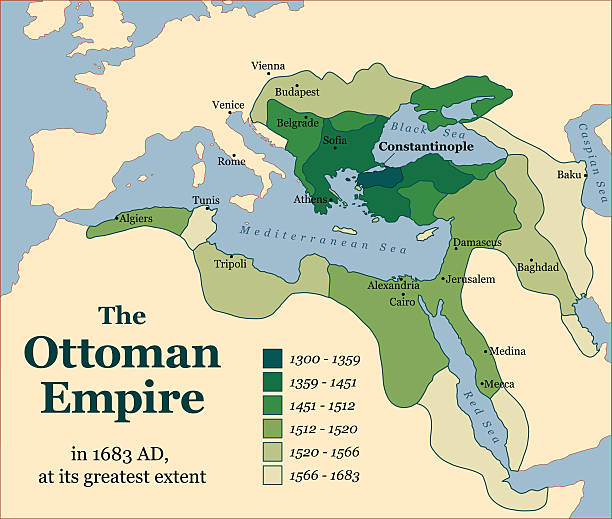There is always something new out of Africa
-Pliny the Elder, Roman Naturalist & Author (AD 23 – AD 79)
Scholars often present African history as a period that begins with ‘European contact’, an era characterized by the massive enslavement of African people and the colonization of African territories. Yet Africa has a rich and deep history that begins with the origin of the human species and includes the development of technology, the formation of early civilizations, and the rise of massive empires that engaged in extensive trade networks connected to Europe, the Middle East, Asia and the South Pacific. African history is human history, and African humanities must therefore begin with the development of humanity and civilization. This lesson will provide a very brief overview of African pre-history and ancient empires.
Lesson Objectives
- identify key milestones in human development on the African continent
- describe the development of agriculture and civilization in Africa
- research and describe the role of an African empire in ancient trade and world history
Cradle of (Hu)mankind

Recent research shows that modern humans developed in Africa. The oldest human remains are located in Ethiopia, and evolutionary scientists have produced DNA evidence that connects all modern human beings to a common ancestor that lived on the African continent. This is what makes African history human history.
The term Hominidae refers to humans and our fossil ancestors. Modern humans are considered primates, and evolutionary evidence suggests that the human hominidae group split from non-human primate groups approximately 4-8 million years ago in East Africa. As you can see from the diagram to the right, Australopithecus afarensis is considered one of the earliest human ancestors in the hominidae group.
Homo habilus, the ‘tool-maker’

Homo habilis is one of the earliest members if the genus Homo. It had a slighhtly larger cranium (brain case) that earlier species, was believed to be the first tool-maker dating to approximately 2 million years ago in the area that is now known as Tanzania. Since its discovery, however, recent tool discoveries are dated slightly older than the oldest evidence of the genus Homo. For more information on H. habilus, visit the Smithsonian Institute’s Human Origins website.
Tool-making is significant because tool-use marks the earliest evidence of human technology. The earliest stone tools were found in Olduvai Gorge in Tanzania, and the style is referred to as Oldowan. The oldest stone tools, known as the Oldowan toolkit, consist of hammer stones, stone cores, and sharp stone flakes used as cutting edges. The Acheulean style is characterized by large bifaces, this means that the tool maker worked two sides of the stone. This style spread throughout Africa & Eurasia.
The Middle Stone Age is characterized by tools styles used by modern humans (Homo sapiens). The Later Stone Age is characterized by major behavior changes, particularly food production. These stone tools include sophisticated tool-making techniques to producing grinding stones, scythes, and other complex tools used in agricultural production. Stone tools are one way to identify different cultural groups among early humans. As humans migrated and formed different groups, they made use of different materials and developed different techniques for tool-making. Tool material can also help archaeologists identify trade networks among early humans by tracking the distribution of different stones (such as granite, marble, limestone, chert, and fossilized coral) into locations where that material is not available. Archaeologists can then deduce that the human group was able to acquire that material through long distance trade.
For more information on stone tools in Africa, visit the Early Stone Age Tools website by the Smithsonian Institute.
Homo erectus, walking upright
Approximately one million years after Homo habilus developed, Homo erectus was the first hominid to walk upright on the African continent. Erectus refers to the ability to walk upright, and this is significant because the ability to walk on two feet rather than four, also known as bipedalism. enhanced survival because it allowed Homo erectus to carry objects and detect predators from a distance. Bipedalism, coupled with the use of tools, helped the homo species acquire food and this advanced cognitive (brain) development. Advanced brain development is evidenced by enlarged craniums (skulls). For more information on H. erectus, visit the Smithsonian Institute’s Human Origins website.
Homo sapians, the wise ones
Approximately 200,000 years ago, anatomically modern humans, Homo sapiens, developed larger brains which allowed for the mental capacity to reason, use language, engage in problem-solving, and develop culture. Enhanced mental capacity combined with bipedalism enabled Homo sapiens to manipulate objects, make greater use of tools, build fires to keep warm and cook food, create clothes, and engage in art. To learn more about the significance of Africa to human evolution, visit the Smithsonian Institute’s Human Family Tree.
Out of Africa
For several thousand years, Homo sapiens continued to develop culture and technology throughout Africa. Approximately 50,000 years ago, a group of Homo sapiens left the African continent. The reasons for the migration are still unclear, yet scientists are certain that all modern humans descended from this single migratory group. Genetic similarities and differences among modern populations reveals a common ‘root’ ancestral population for all modern human groups. This ancestor is referred to as ‘Mitochondrial Eve’ because the DNA connection exists in the mitochondria, a genome that is passed from the mother to child. To learn more about human evolution in Africa, watch ‘Seven Million Years of Human Evolution,’ by the American Museum of Natural History, below.
As Homo sapiens spread throughout the world, they encountered different environments which necessitated adaptation. Humans in cold and dark environments developed lighter skin to better capture and make use of solar UV rays. Humans in high altitudes developed larger chests to make better use of oxygen in low-oxygen environments. As the human species colonized the globe, biological and cultural diversity flourished.
Hunter-Gatherers and Pastoralists
Until 10,000 years ago, all human groups were hunter-gatherers, also known as foragers. Foragers extract wild game and uncultivated vegetable resources from the natural environment. Most foraging societies are organized into a group of bands that consist of fewer than 100 people. Foraging groups are generally mobile according to seasonal variations in the availability of game and vegetable resources. A number of foraging groups continue exist taday in remote areas of Africa, Asia, and the Americas. Yet, most contemporary foragers are at least partially connected to food production or external assistance (Kottak 2012). Pastoralists rely on the domestication of animals such as cattle, sheep, goats, camels, yak, and reindeer. The domestication of animals is believed to have originated in Egypt with the management of animals such as gazelles, oryxes, and hyenas as well as in West Asia with the domestication of herding animals such as sheep, goats, and cattle. Pastoralists engage in a symbiotic relationship with animals; the pastoralists provides protection and resources to the herd, and the animals provide milk, meat and hides to the pastoralists. Most pastoralists supplement their diet by hunting, gathering, fishing, cultivating, or trading with their neighbors. Like foragers, pastoralism demands mobility according to seasonal variations in water and pasture for animals. Most hunter-gatherer and pastoral groups, past and present, engage in Nomadism which refers to the mobility pattern when the entire group moves with the animals throughout the year. Transhumance refers to the mobility pattern when only part of group moves with the herds and most people stay in the home village. Many communities in Africa and throughout the world continue to rely on nomadism and transhumance for survival, yet these livelihoods demand a vast expanse of open space to support hunting and/or the grazing habits of herding animals. In many cases throughout the world, pastoral groups have become trapped between national borders, protected areas, urban development, and other barriers that prevent seasonal migrations and mobility. As a result, increased competition over scarce land and water resources has generated violent conflicts, called pastoral wars, between different groups. Recent research has shown that pastoralists engaged in pastoral wars are experiencing Post- Traumatic Stress Disorder (PTSD) that is comparable to the PTSD experienced by American troops returning from Iraq and Afghanistan.
Watch: When the Water Ends: Africa’s Climate Conflicts
From Agriculture to Civilization
Cultivation is the intentional manipulation of the vegetative environment in order to maximize food productivity. Horticulture is cultivation that does not make intensive use of land, labor, capital, or machinery. Horticulturalists use simple tools, slash-and-burn techniques, and crop rotation to allow plots to lay fallow and recover from land-use. Archaeological evidence, such as sickle blades and grinding stones, suggests that agriculture, which is intensified food production associated with large sedentary societies, originated in the Middle East and North Africa approximately 10,000 years ago. Cereal production became a staple food crop in agricultural areas where biodiversity was not sufficient to support large groups of people. Agriculture demands intensive use of land and technological inputs such as irrigation, terracing, fertilizer, transport, and additional labor energy harnessed from animals, exploited humans and fossil fuels. As a result, agriculture led to more sedentary settlement patterns and greater time spent in one location not only led to the development of pottery, art, and architecture, it also produced larger and more complex (hierarchical societies).
The development of agriculture is the keystone to the development of large civilizations, or chiefdoms, because sedentary settlements allowed for increased population density and social stratification, building constructions, the emergence of arts and crafts, and the need to develop laws and political systems to organize and regulate a large and diverse society. Approximately 5000 years ago, the first states began to form in Mesopotamia, followed by Egypt, the Indus Valley, northern China, southern Africa, Meso-America, the central Andes and the feudal system in Europe.
By the 15th century, large empires and civilizations in Asia, Europe and Africa were interconnected by a vast network of maritime and land transportation systems. While many civilizations collapsed as a result of widespread diseases and epidemics, environmental degradation and war, others continued to develop into states, ‘an autonomous political unit encompassing many communities within its territory, having a centralized government and the power to collect taxes, draft men for work or war, and decree and enforce laws’ (Carneiro 1970:733). States are characterized by highly defined social hierarchies that are organized according to created categories such as class, caste, ethnicity, gender, etc. (Weber 1922). As population pressures and competition among states increase the demand for additional resources, state political units must expand their territory and acquire more resources to support a growing civilization (Bodley 2007). Expanding states are called empires because they encroach and consume the territories and resources of other political groups. We will explore states and empires further during the next module on Colonialism. For now, however, it is important to note that massive kingdoms developed in Africa and existed well into the colonial era. These kingdoms were integrated into a vast global trading network that connected African kingdoms and empires to Asia, India and Europe.
African Empires and Kingdoms
Throughout history nearly 100 kingdoms are known to have existed in Africa. Each kingdom engaged in trade, and sometimes war, with nearby kingdoms. Although the kingdoms were connected through trade and transportation networks (waterways, caravans, etc), historians group the kingdoms into five categories based on their locations: the North African kingdoms along the Mediterranean coast. The Nile Valley Kingdoms centered on the Nile River in the North Eastern area of Africa. The West African kingdoms clustered around the Niger river and the Niger river Basin. The Central African Kingdoms that dominated the interior area of the continent. The South African Kingdoms occupied the Southern portion of Africa, including the Kalahari Desert. Although African Kingdoms have been largely left out of late European history, archaeological evidence as well as historical documents produced by ancient Egyptian, Greek and Roman authors provide evidence that African kingdoms played a central role in the development of world civilization and the circulation of key resources used by European Kingdoms and the Dynasties of Asia.
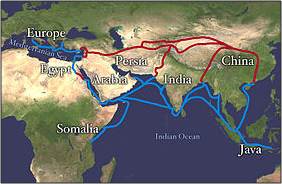
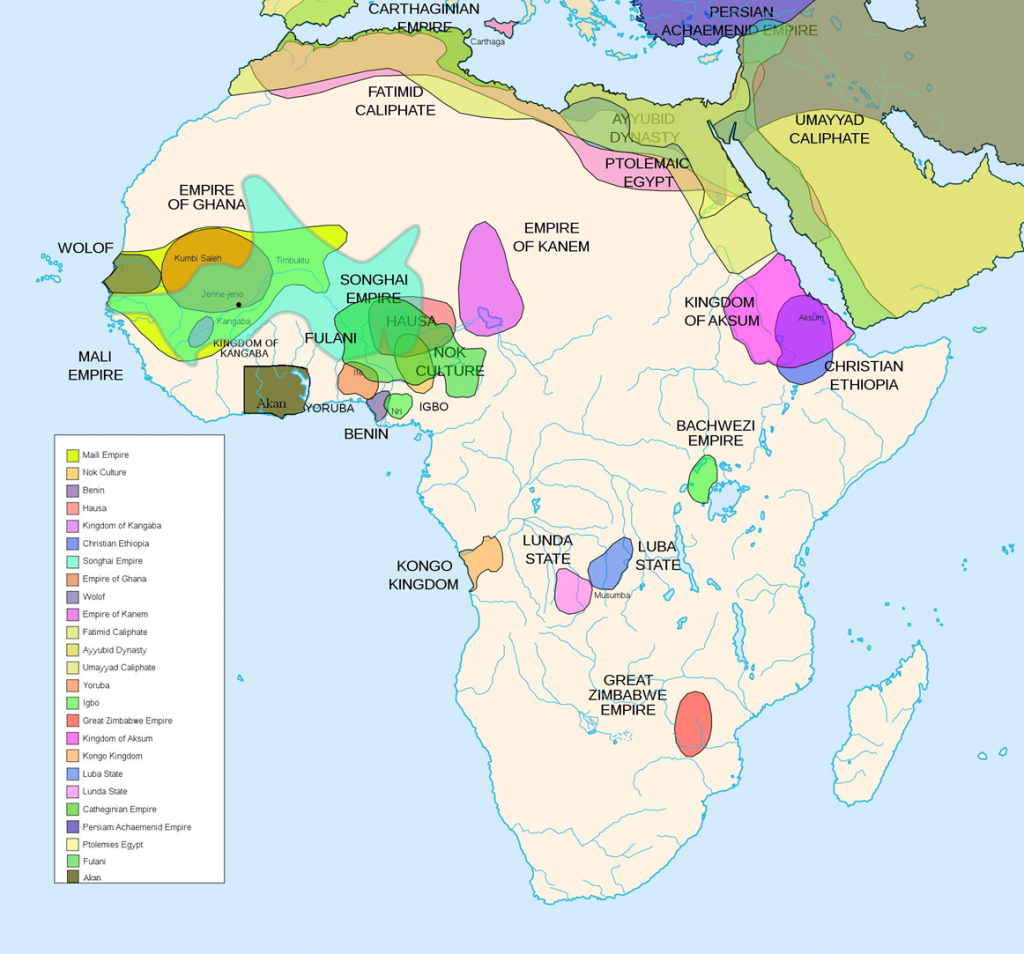
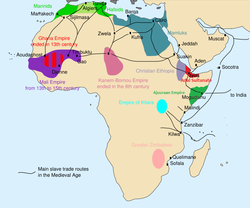

North African and Nile Valley Kingdoms
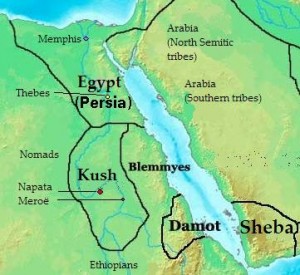
The Nile Valley Kingdoms were located along the Nile River and North East Africa. They include ancient Egyptm known as Kamut, as well as the Akxomite Empire which was a major marine power and trading partner with the Roman Empire, and the Kushite Kingdom (400BC-1000AD) which has been mentioned in Biblical texts. The Kingdom of Nubia covered an ever-widening area of the Middle Nile Valley and surrounding deserts that extend approximately from Aswan in Egypt south to modern Khartoum, Sudan, and beyond. It was a highly advanced society governed by dark-skinned people that rivaled Egypt in wealth, power and cultural development. Egypt was occupied by Nubian kings who governed Egypt as pharaohs for more than 100 years between 1970 and 1520 B.B. The kingdom developed a new form of writing as well as an advanced iron industry. Yet, the kingdom was invade by Akxom in around 300 A.D. Today, a vast amount of Nubian land lies underwater beneath massive reservoirs created by colonial dams. Yet, nearly one million Nubian people remain in the southern region of Egypt and the northern region of Sudan.
Another ancient kingdom, which the Egyptians called ‘Kush’ and the Greeks and Romans called ‘Ethiopians’ and/or ‘Burnt-Faced Ones’, rose to prominence in the third millennium B.C. The Kushite kingdom was a well-established urban, literate kingdom that existed at the same time as the Egyptian kingdom. The Kush kingdom engaged in trade and communication with Egypt, Greece and Rome while remaining linguistically and ethnically diverse. In addition, the oldest Christian Church, the Ethiopian Church, was established in the Nile Valley region during the 4th century BC.
During the Hellenistic Period, Ancient Greece and Egypt maintained close trading relationships. In North Africa, the former Phoenician colony of Carthage (modern Tunisia) rose to dominate its surroundings with an empire that contained many of the former Phoenician holdings. However, it was a city on the Italian Peninsula, Rome, that would eventually dominate the entire Mediterranean basin. Spreading first through Italy, Rome defeated Carthage in the Punic Wars, despite Hannibal’s famous efforts against Rome in the Second Punic War. After the Third Punic War, Rome became the leading force in the Mediterranean region.
The Romans soon spread east, taking Greece, and dominating the Mediterranean. The Mediterranean sea was referred to as Mare Nostrum (Latin: “Our Sea”) by the Romans. The importance of the Mediterranean rested on the relationship with North African empires; trade stimulated commerce and naval development. The coastal trading cultures became dominant over the inland river valleys that had once been the heart of the great African powers. Egyptian power moved from Nile cities in the south in areas such as modern day Sudan, to coastal ports, such as modern day Alexandria. To learn more about Rome in Africa, read the article, ‘The Roman Road Across North Africa,’ by the British newspaper, The Telegraph.
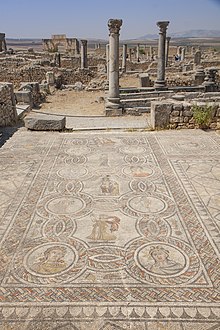
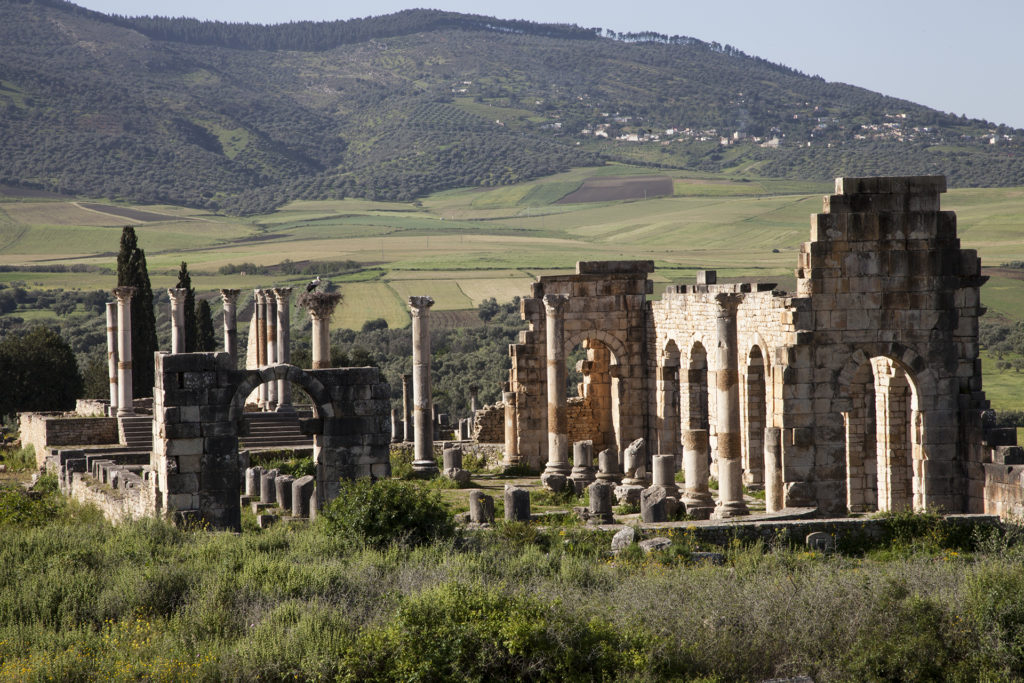
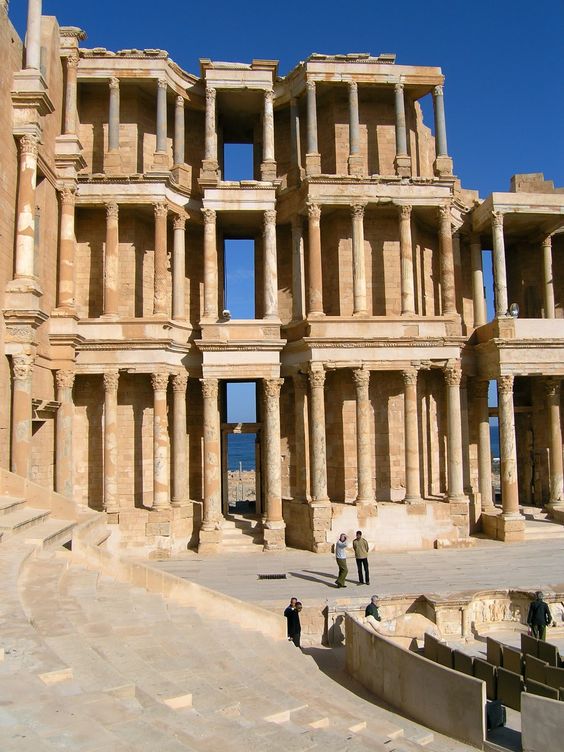
The close relationship between Rome and North Africa created opportunities for African people to participate in Roman society, and in many cases, African people held leadership positions throughout the empire. For example, the Roman Emperor Septimius Severus was born in Leptis Magna in North Africa, in what is now modern-day Tripolitania, Libya. As the Roman empire expanded across Europe, African people also expanded across the empire and moved as far as Britain during Roman rule. As early as the third century, St Maurice—an Egyptian—became leader of the legendary Roman Theban Legion. Ever since, there have been richly varied encounters between those defined as ‘Africans’ and those called ‘Europeans’. The video below presents archaeological evidence about black Africans in Roman Britain.
The Roman empire began to crumble, however, and the collapse of the Western Roman empire after 476 CE opened the door to the Ottoman Empire and the spread of Islamic kingdoms across North Africa and into West Africa by the 7th century. This fundamentally changed the social, cultural, religious and economic landscape of the region.
Islamic Empires in Africa
Following the conquest of North Africa by Muslim Arabs in the 7th century CE, Islam spread throughout West Africa via merchants, traders, scholars, and missionaries and into East Africa when Arab traders settled along the Swahili Coast. During the period known as the Crusades by Europeans, Ottoman military campaigns occurred from the 14th century CE against the Christian kingdoms of Nubia, for example, while in the 18th century CE the Muslim Fulani launched a holy war in the Lake Chad region. There were also sometimes violent resistance by supporters of traditional African beliefs such as animism and fetish, spirit and ancestor worship.
Islam spread from the Middle East to take hold across North Africa during the second half of the 7th century CE when the Umayyad Caliphate (661-750 CE) of Damascus conquered that area by military force. From there, it spread via Islamized Berbers (who had been variously coerced or enticed to convert) in the 8th century CE along the trade routes which crisscrossed West Africa, moving from the east coast into the interior of central Africa, finally reaching Lake Chad. Meanwhile, the religion also spread down through Egypt and swung westwards through the Sudan region below the Sahara Desert. A third wave brought the religion to Africa’s eastern shores, the Horn of Africa and the Swahili Coast, directly from Arabia and the Persian Gulf.
As Muslim traders penetrated deeper into Africa so the religion spread from one empire to another, taking hold first at Gao in 985 CE and then within the Ghana Empire (6th-13th century CE) from the late 10th century CE. From there, the religion spread eastwards to the Mali Empire (1240-1645 CE) and the Songhai Empire (c. 1460 – c. 1591 CE). With the adoption of Islam by the rulers of the Kingdom of Kanem (c. 900 – c. 1390 CE) between the 11th and 13th century CE and Hausaland from the late 14th century CE, the religion’s encirclement of Africa below the Sahara Desert was complete.
In East Africa, Islam faced stiff competition from Christianity which was firmly entrenched in Nubia and states such as the Kingdoms of Faras (aka Nobatia), Dongola, and Alodia, and in the Kingdom of Axum (1st – 8th century CE) in what is today Ethiopia. It was not until the 14th century CE and military intervention from the Mamluk Sultanate of Egypt (1250-1517 CE) that these Christian kingdoms became Muslim, the exception being the Kingdom of Abyssinia (13th-20th century CE). In addition, two important Muslim states in the Horn of Africa were the Sultanates of Adal (1415-1577 CE) and Ajuran (13-17th century CE).
For more information about Nile Valley Kingdoms, watch the following documentaries:
Egypt’s Golden Empire: Over 3,500 years ago, Rome was no more than a soggy marsh and the Acropolis was just an empty rock, but Egypt was on the brink of its greatest age – the New Kingdom.
Hannibal: the Fall of Carthage: This documentary delves into the rise of the small trading city-state of Carthage that became one of the richest and most powerful seafaring nations in the Mediterranean. Following the battles of the great Carthage general, Hannibal, the defeat of Rome seemed almost inevitable, yet Rome prevailed. Watch online:
Nubia: The Forgotten Kingdom: Once a powerful, sprawling presence in Northern Africa, the ancient kingdom of Nubia now lies buried beneath mounds of red brick rubble in the Sudan. Forgotten by history and largely neglected by archaeology, its cities have lain buried for centuries, harboring priceless secrets of a civilization that once rivaled Egypt.
Central African Kingdoms

The Central African Kingdoms were located in the southern region on the African continent. The fertile region of central Africa gave rise to several powerful civilizations with sophisticated cultures and technologies. In the east, between the Zambezi and Limpopo rivers, a grassland allowed cattle to prosper and gold deposits generated immense wealth. By the 13th century, Great Zimbabwe (1100-1450 AD) dominated the region and the ruins of a spectacular fortified palace remains today. By the 15th century, Mutapa rulers invaded Zimbabwe at a time that coincided with the arrival of Portugese traders. As the Portugese made there way across, what is now Angola in the West to Mozambique in the East, they encountered several powerful kingdoms such as Kongo (in modern northern Angola and Democratic Republic of Congo), Lunda, the Lundu Kingdom and others. As the documentaries below describe, Great Zimbabwe included massive architectural structures and it was initially attributed to ‘non-Africans’by a colonial German geologist. Today, historians consider Great Zimbabwe as one of the most complex and massive kingdoms on the continent and it was undoubtedly created by African people.
For more information on Central African Kingdoms, watch the following documentaries:
West African Kingdoms
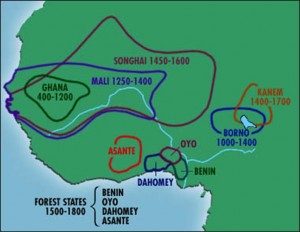
West African Kingdoms were connected by the Niger River. Between the 9th and 16th centuries CE, three specific West African kingdoms came to power: Ghana, Mali, and Songhay.
The Kingdom of Ghana became a powerful, centralized kingdom between the 9th to 13th centuries. (Note that the area of the Kingdom of Ghana during this time period is farther north than the present day country of Ghana.) Like many African kingdoms, its success was based on extensive commercial trade with other kingdoms, particularly the trade of gold. In ancient literature, Ghana was referred to as the ‘land of gold,’ and the people of West Africa developed a unique technique for mining gold for trade with other African and European kingdoms. At that time, Ghanaian gold was traded for salt from the Sahara region. During the 11th century, Muslim Almoravid descended from North Africa to conquer the Kingdom of Ghana and convert people to Islam. This allowed the Kingdom of Mali to gain power, dominate the region, and take control of commercial trade.
The Kingdom of Mali reached its peak between the 13th and 15th centuries. During that time, Mali was the second largest empire on the planet (after the Mongolian empire in Asia). as you can see from the map, the Kingdom of Mali encompassed the entire territory of Ghana, stretching from the Western coast to beyond the Niger river. During this time, the Kingdom of Mali expanded commercial trading in the region and took control of trade in gold and salt, and occupied the caravan routes that penetrated the Sahara desert. This enabled Mali to trade extensively with Egypt and acquire cooper resources from African Kingdoms occupying the Nile region. Islam flourished in Mali, and it became well known for several great Islamic centers such as Timbuktu, Djenne, and Gao. These centers contributed a wide body of knowledge in the fields of religion, mathematics, music, law, and literature.
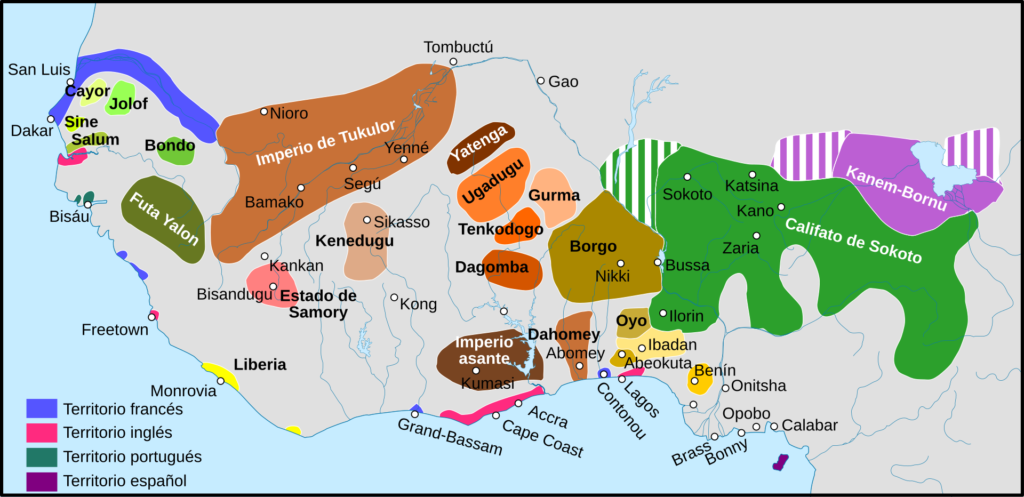
What role do waterbodies play in this relationship?
The Kingdom of Songhay gained control over some parts of Mali, and the civilization peaked during the 14th and 17th centuries CE. Songhay territory extended west from the northernmost peak of the Niger river to the eastern interior of the continent. The Niger river connected the kingdom to the coastal resources and trading ports. The integration of commercial trade networks and Islamic religion helped the Songhay civilization prosper because Islam unified people throughout the region and thereby facilitated the flow of goods and people between Islamic powers. Like Mali, the Songhay civilization developed sophisticated learning centers that encouraged scholarship and learning. By the beginning of the 15th century, the kingdom expanded into a strong, militarized central government with a complex legal structure. The kingdom experienced relative peace until the the 17th century when Moroccan invaders seized power of Songhay.
This is just a brief overview of only a few notable West African kingdoms. To learn more about the significance of the Niger River Valley for the development of West African Kingdoms and their interconnections through trade, watch the brief documentary below.
Interconnections: Ancient Trade and Migrations
A wide range of powerful and sophisticated civilizations and kingdoms developed on the African continent for several thousand years. These kingdoms produced a significant amount of wealth and resources, and many kingdoms traded with each other as well as European and Asian trading partners in a complex world economy. In the next lesson, we will explore the ways that the trading networks that connected African kingdoms to each other and to the rest of the world played a pivotal role in the enslavement of African people with the development of the ”Trade Triangle’. Through a series of historical events, trading relations between European Kingdoms and African Kingdoms changed, and this set the stage for more than four centuries of war and turmoil throughout the African continent. The outcome of this rift transformed life on the African continent, and the relationship between Africa and Europe continues to underlie contemporary experiences in Africa today.
Questions to Consider
- Reflect on the development of early humans and their ancestors in Africa; Homo habilus, Homo erectus, and Homo sapien. What are their defining features and contributions to humanity?
- What type of technologies developed in Africa, and how did those technologies change the ways people lived?
- Reflect on the different civilizations in Africa; North African, Nile Valley and Horn, West African, and South-Central. What are their defining features and contributions to humanity? How did the environment shape the nature and character of the kingdom?
- In what ways did trade connect African kingdoms to each other and to the rest of the world?
References & Resources
- Africa’s Great Civilizations, PBS
- Lost Kingdoms of Africa, BBC
- Exploring Africa, Michigan State University
- Kingdoms, Boston University
- Kingdoms of Gold, Castilleja School, California.
- African Empires, Central Oregon Community College.
- Civilisations in Africa: Ghana, By Richard Hooker, World Civilizations
- Mali Interactive,Website by Rice University
- The Dogon Blacksmiths, Laboratory of Prehistory and Ethnoarchaeology, Universite de Geneve.
- Background to Sundiata Keita, West Chester University Department of History.
- Empires of Mali and Ghana, PBS
- Imperial Africa, Black Studies Library Website, Ohio State University Libraries
- Kanem-Borno, World Civilizations site. By Richard Hooker.
- Advent of Islam to West Africa, Baobab Project, W.E.B. DuBois Institute.
- The African Predicament
- Ancient History of Africa (film)
- Origin of Agriculture in Africa
What did you about African prehistory and empires? Take the ungraded quiz below to find out.
Sorry. The requested quiz has been disabled.
For Discussion in Canvas
Research and describe the African empire that occupied the territory that is now known as the African nation you selected. What is known about that empire today? Include a map of the empire’s territory and images of artifacts if they are available. In what ways was the kingdom connected to other empires throughout the world? What significant contributions developed in that empire? *Do not forget to organize your response as Introduction-Body- Conclusion, include formatted citations in your post, and to respond to other student posts.

